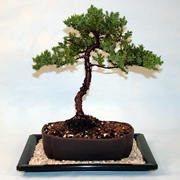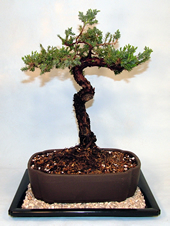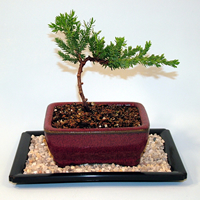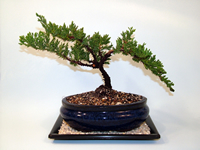|
Growing your Juniper Bonsai
Junipers are one of the most popular forms of bonsai. There are many different varieties including Japanese Garden Junipers, Green Mound, Sargent's, Needle, Shimpaku, and Chinese Junipers, just to name a few. Junipers are also one of the easiest forms of bonsai to take care of. Juniper bonsai grow both indoors as well as outdoors, however, they should be kept in a cooler environment during the winter months in order to experience a winter rest period. Following a few simple guidelines allows Juniper bonsai to be grown without difficulty. |
 |
 |
|
Watering
Junipers, as with most bonsai, like to dry out between waterings. Feel the soil every day. If there is a rock in the planting lift it up and feel under it, otherwise, just stick your finger about a half of an inch to an inch into the soil. If the soil feels dry, water your bonsai. Never let your bonsai go totally dry for extended periods!!! The best way to water your bonsai is to soak it in a sink or container of water up to the trunk for about 5 to 10 minutes. Then allow it to drain. If top watering your bonsai, water, wait a few minutes, and water again. Repeat this several times to insure that your bonsai has received a thorough watering. Eventually you will be able to determine a watering schedule that meets your climate conditions. |
|
Light
Filtered or shaded sunlight is best for your Juniper bonsai. Allow your Juniper bonsai to get low intensity morning sunlight when possible and avoid the direct afternoon sunlight. |
Feeding
Fertilize your Juniper bonsai once every two weeks during the growing season, spring until fall. We recommend using an organic liquid fertilizer such as a fish emulsion or an organic seaweed fertilizer. Chemical fertilizers may be used but should be diluted to approximately one half strength so that valuable roots are not damaged. Organic pellets such as rice cakes may also be used along with regular fertilizers.
|
 |
|
Humidity
Humidity around your Juniper bonsai may be maintained by the use of a humidity tray or plate filled with stones and water. Your bonsai can be placed on top of the stones in the tray. The tray or plate will also offer protection from the draining water of your freshly watered bonsai. Misting once a day will also help…but remember, misting is not a replacement for watering. |
|
Repotting
Junipers should be repotted about every two years when young (less than five or six years old) and every three to five years thereafter. Junipers may be repotted throughout most of the year, although, the best times for repotting are in the spring and fall. After repotting, water thoroughly and keep the plant in a shady location for several weeks so that new roots may grow. |
Winter Care
To maintain good health, Juniper bonsai should be kept in a cool (under 60 degrees F) during the winter months so that they can experience a dormancy or rest period. During this period your bonsai should be protected from drying winds and extreme cold conditions. This can be achieved by utilizing cold frames, window wells, enclosed unheated rooms, or mulch beds. |
 |
Moss
Moss is certainly not essential to growing bonsai, but when moss is added to a bonsai it both enhances its beauty and improves moisture retention within the bonsai pot. If your bonsai has moss growing in it you can help to keep it alive by misting it regularly. If the moss dies, you may replace it with some of your own moss from your backyard.
Endnote
These instructions, when followed properly, will help keep your bonsai healthy and beautiful. There are many more publications available that offer more in depth information about your bonsai and we encourage you to read some of them. There are also local bonsai clubs and societies that offer many great learning experiences in the area of bonsai.
We hope you enjoy your bonsai experience as much as we have enjoyed ours. |
|
|
|